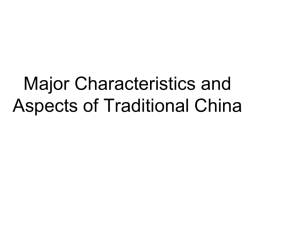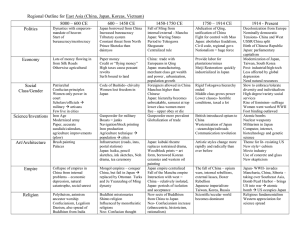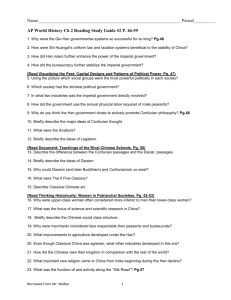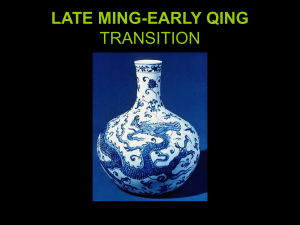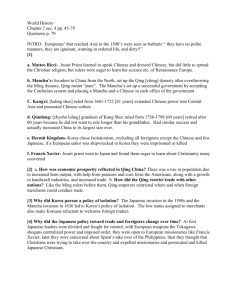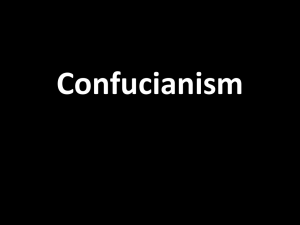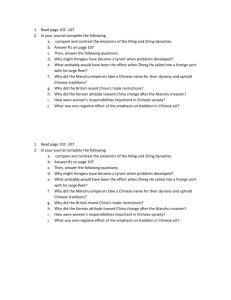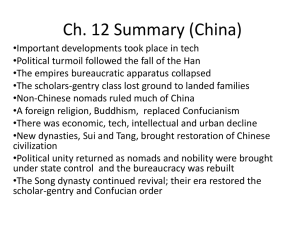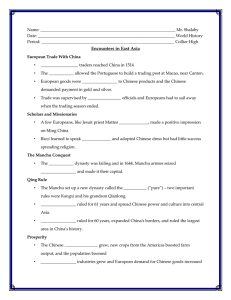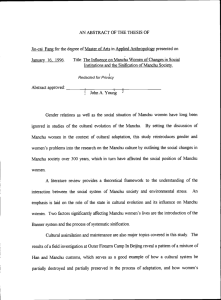Section One: Introduction to China Powerpoint
advertisement
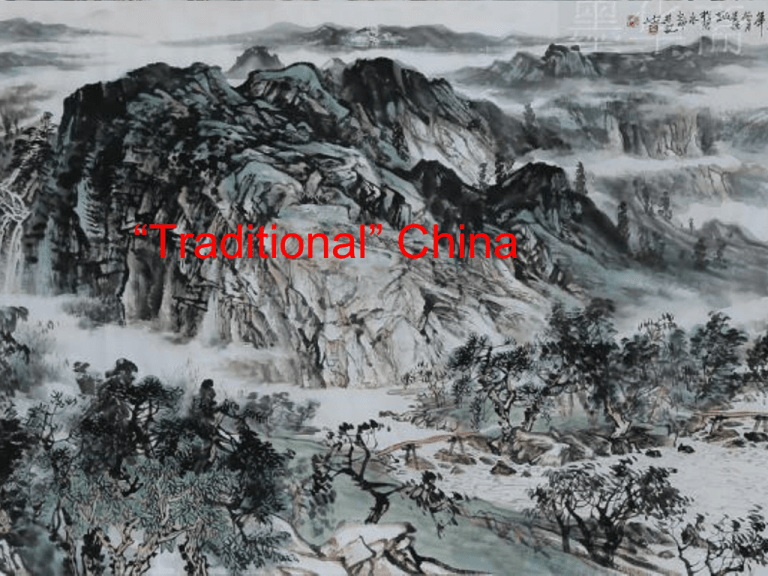
“Traditional” China In Interests of Full Disclosure! • Much of the following is shamelessly appropriated from Dr. John Leung’s original set of slides on Traditional China Overview • • • • • • • Geography History Society Culture and Ideologies Political Structures and Systems Changes and World Views Misrepresentations and Lead Up to War Regions of China From http://homepages.stmartin.edu/Fac_Staff/rlangill/HIS%20217%20m aps/China%20regions.jpg History • A continuous recorded history of a political and cultural formation that arose as early 1300 BCE • Difference with South Asia (India): political control over most of “China proper” since about 211 BCE • Though important not to OVERPLAY the nature of this, to assume homogeneity, or that a single ideology -- social, political, or cultural -- pervaded the entire area. • Many divisions too • Ethnic co-existence and contestation: “The Chinese” is a modern social and political “construction.” “China” traditionally (and now) is a multiethnic and multicultural entity, fraught with issues of co-existence and contestation. (Periods of non-Han rule of all or parts of China) Northern dynasties 386-581 CE Liao 907-1125 Jin 1115-1234 Mongol/Yuan 1206-1368 Manchu/Qing 1644-1911 (Total: 933 in 2231 yrs. = 42%) (Major ethnicities) Han, Meng (Mongol), Hui, Uighur, Zang (Tibetan), Man (Manchu), Yue, Zhuang, Bai, Yue (Viet), Dai (Thai), Min Society • Hierarchies: Classes Gentry (two intertwined types: govt & landed) peasant farmers (the vast majority; broadly differentiated by economic prosperity levels/classes within the category) industrial workers, artisans, and the commercial class: Culturally demeaned but real historical growth; Commercial economies mostly medium and small; industry run the gamut from peasant household-based “cottage industries” to large scale productivity industries (e.g., mining.) Limited mechanization until late-19th C • Patriarchy dominant throughout traditional Chinese (esp. Han) society. Reinforced by “neoConfucian” ethics since 12th C Society cont’d • Economically: widely divergent regional rates of development: influenced by many factors besides geography Core vs. peripheral Hinterland vs. coast North vs. South Urban vs. rural • Ethnic divisions : Han vs Manchu we will hear more about, but many more too Thought & Culture • (Vohra, pp. 5-10) • “Confucianism” – dominant ideology of Chinese society and state since 1st Century BCE Original teachers: Kong Qiu (“Confucius”) ca. 550-480 BCE Meng Ke (“Mencius”) ca. 370-290 BCE Xun Qing (“Xun zi”) ca. 313-238 BCE Five Cardinal Relationships: Father-son; Sovereign-subject; husband-wife; older brother-younger; friend What does “Confucianism” mean? It is both Philosophy and Orthodoxy – the underpinning of a concept of a rigid universal social and state order IMPERIAL CONFUCIANISM emerged as a mix of Confucian and LEGALIST ideas, emphasize the importance of laws, strict punishment, and political control. The establishment of Imperial order Helps sustain support of auxiliary social systems (govt. endorsement, bureaucracy, education, examination system – ladder of success) Extension of Confucian cultural influence and the expansion of the Chinese empire • Other cultural influences Philosophical traditions: Daoism, Me-ism, Legalism, ancient Scientism Buddhism (introduced in 1st C CE; processes of Sinicization; becomes one of the major pillars of cultural connection between China – including the Chinese state – and the rest of Asia; unquestionably the most populous religious system in China, if not in Asia; Buddhism’s varieties – not a monolithic system of belief in China) • Significance of Confucianism for our comprehension of Modern China Orthodoxy: tremendous and deep influence on Chinese society, values, and state Notion of MANDATE OF HEAVEN. But mandate of heaven could be withdrawn and as “heaven sees as people see” implied that if people disssatisfied, then rebellion justified Enduring tradition but also target of change Manchu monarchy adopted and adapted itself to the Confucian order and its teachings – hence in the modern period rebellion against the Manchu imperial system also involved to some degree rebellion vs. Confucianism Relationship between Confucian orthodoxy and other influences: Fairly peaceful coexistence due to the “division of spheres” over the centuries (contrast with situation in Europe) – Projection: A very different set of conditions in terms of “inter-system” and “inter-cultural” relations comes into play when 19th evangelical Christianity, supported by the power of Western states, is introduced into the equation in the “modern era.” (In other words, the ways in which Christianity sought to impact China in the 19th century was nothing like the ways in which other non-indigenous religions, such as Buddhism, had done in the past. Thus the responses were also very different.) Political Structures & Systems • • • • (Vohra, pp. 2-3; 7; 10-11; 12-14) Monarchies and dynasties SCHOLAR-GENTRY Bureaucracy: Officials chosen for “merit” (however that maybe defined) vs. a nobility-dominated govt. has been a characteristic of MOST (not all) of traditional Chinese political history Bureaucracy existed UNDER monarchy • The “Mandate of Heaven” concept applied to the legitimation of imperial rule and dynastic prolongation (compare w/ “Divine Right of Kings” in Western tradition of monarchical absolutism) • Constant tension between Central govt. (centralism) and the politics and power of the regions: Persistent regionalism; several times resulted in political division China Compared, ca. 1600 • In1600 China one of the largest, most sophisticated realms in the world. • Larger than Russia in 1600, by when India was not yet fully integrated under Mughals and American empires in decline, only Ottomans comparable • Technologically, Chinese skills in printing, manufacture (porcelian and silk, e.g.) unparalleled • Nearby societies either conquered or modelled their own states and societies on Chinese models. • Not for nothing then did the Chinese consider themselves the MIDDLE KINGDOM Changes and World View • 1644 the Han Ming Dynasty gives way to the Manchu Qing • Qing/Manchus adopted “traditional” ideologies and practices of government, patronize Confucian scholars etc. • Also maintain idea of “middle kingdom” and label of but as Vohra tells us, in practice deal with different Misrepresentations • Manchu policies were misrepresented by Western traders • Chinese conceptions of law were different. Few written law codes. Law based on COLLECTIVE and not INDIVIDUAL responsibility. Thus family or lineage or even clan or tribe could be punished. • Not xenophobic, but a Chinese way of looking at the world shaped by own history. Not interested in outside world, because they did not need need anything Times Were a Changin’ • First SILK and then TEA make China trade very attractive to Western traders • Imbalance of Trade, so large outflow of precious metal from West to China • Need to balance this trade • Found in OPIUM, a commodity the EIC could grow in India (that they controlled by early 19thC) • Opium leads to war, the first war on drugs with the British and the US as the drug runners.
